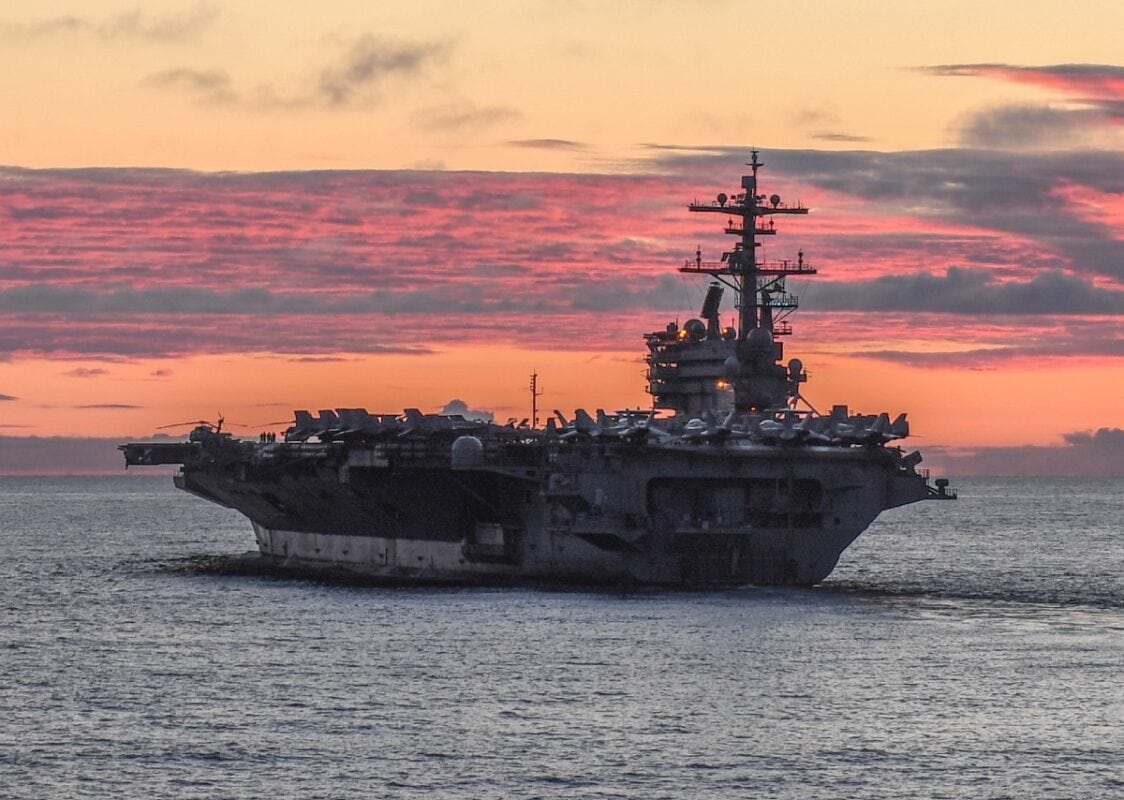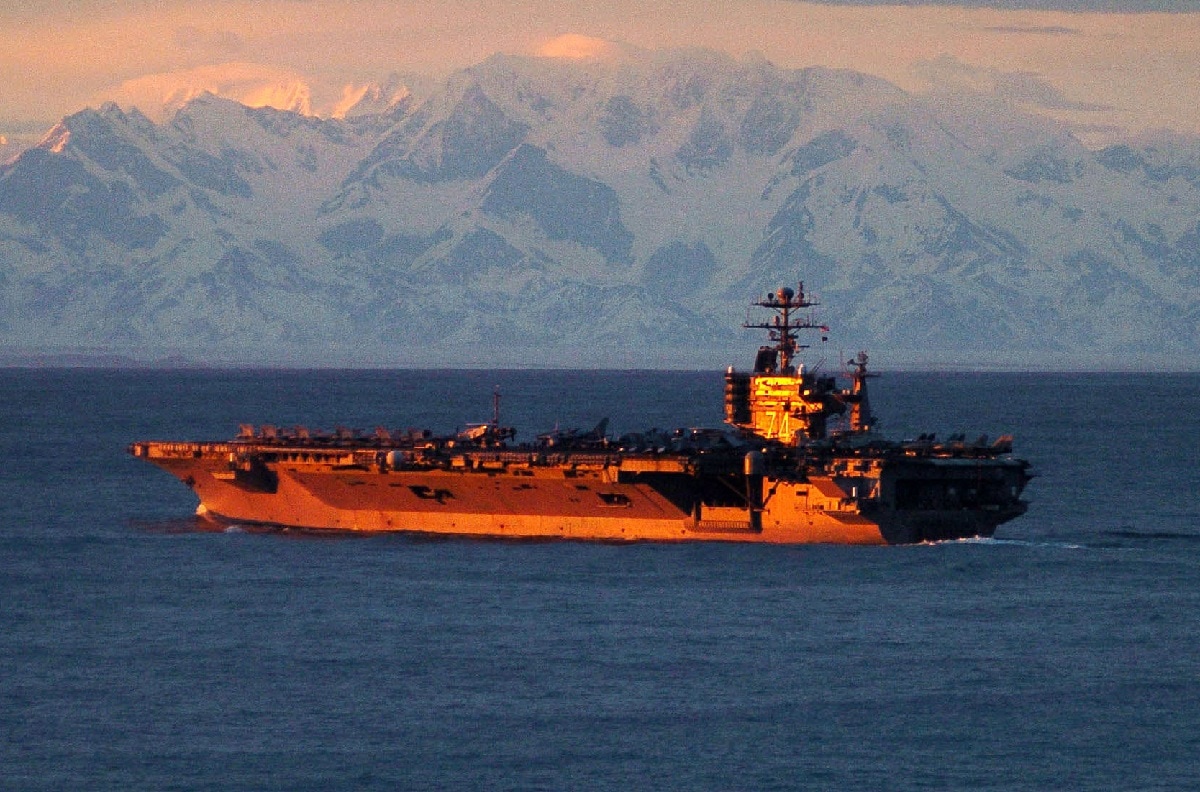The Nimitz-class Aircraft Carriers Remain a Classic: The USS Gerald R. Ford (CVN-78), the United States Navy’s latest and largest aircraft carrier, is now years behind schedule and well over budget. The warship was formally commissioned in July 2017, but won’t actually begin her maiden deployment until at least this fall. CVN-78 isn’t a bad design; it is reported to be one of the most capable warships ever built – yet there continue to be issues with its weapons systems and ability to launch and recover aircraft.
The U.S. Navy had sought to develop a new class of carriers – one that was loaded with advanced features and capabilities – but that may now seem to be misguided as it already had a perfect carrier in the Nimitz-class.
Meet the Nimitz-class
At 1,092 feet, the Nimitz-class supercarriers are more than three times the length of a football field, and with a crew of 3,200 sailors and 2,480 airmen, each is essentially a floating airbase that can play an important role in modern power projection. The lead ship of the class, USS Nimitz (CVN-68) – named after Admiral Chester Nimitz, who led the U.S. Navy through the Second World War and nicknamed “Old Salt” – may have been commissioned in May 1975, but she and her sister ships still greatly exceed the capabilities of any other nation’s warships. A total of ten Nimitz-class carriers have been built, with the last of the class, USS George H.W. Bush (CVN-77) was commissioned in January 2009. These were the largest warships in the world until the USS Gerald R. Ford.
Each of the nuclear-powered carriers, which have two reactors and four shafts for propulsion, can reach a top speed of 30+ knots (34.5mph). The supercarriers have an expected 50-year service life with one mid-life refueling.
Best in Any Class
The Nimitz-class aircraft carriers were developed to supplement the Kitty Hawk-class and Enterprise-class. The new carriers, which took on improvements over the Enterprise– and Forrestal-class supercarriers, were also similar in design of the Kitty Hawk-class. Among the design improvements were the two nuclear reactors that took up less space than the eight reactors of Enterprise. That allowed each Nimitz-class carrier to carry 90 percent more aviation fuel and 50 percent more ordnance compared to the Forrestal-class.
In addition, the new supercarriers were designed to withstand three times the damage sustained by the Essex-class inflicted by Japanese air attacks during World War II. This included hangars on the ships that were divided into three fire bays by thick steel doors that are designed to restrict the spread of fire.
These warships, which have a displacement of 102,000 tons, were all built by Huntington Ingalls Industries Newport News Shipbuilding (now Northrop Grumman Ship Systems) based in Virginia at a unit cost of approximately $8.5 billion (constant year FY 12 dollars).
Power Projection
Each of the Nimitz-class aircraft carriers can be embarked with approximately 60 aircraft, including a variety of fixed-wing and rotary-wing aircraft with up to 90 of various types. Typical aircraft on the Nimitz-class carriers include 12 F/A-18E/F Hornets, 36 F/A-18 Hornets, four E-2C Hawkeyes and four EA-6B Prowlers fixed-wing and helicopters, including four SH-60F and two HH-60H Seahawks. In addition, the carriers could also deploy the S-3B Viking, before these were phased out and replaced the F/A-18E/F Super Hornet. USS Carl Vinson (CVN-70) was the first of the Nimitz-class carriers to undergo a refit, which allows the flattop to carry the Navy’s Lockheed Martin F-35C Lightning II – the carrier variant of the Joint Strike Fighter.
The flight deck, which measures 1,092 feet by 252 feet, is equipped with four lifts, four steam-driven catapults and four arrester wires. The carriers are capable of launching one air every 20 seconds.
The air wings of the carriers are customized according to the nature of operations, with the usual air wings replaced with 50 army helicopters on the USS Dwight D. Eisenhower (CVN-69) during the carrier’s operations in Haiti in 1994. Similar considerations can be made when a carrier is used for disaster response and humanitarian assistance.
In addition to the aircraft, the mostly recently built Nimitz-class carriers are now armed with three Raytheon GMLS mk29 eight-cell launchers for NATO Sea Sparrow surface-to-air missiles, which have semi-radar terminal guidance. There are also four Raytheon/General Dynamics 20mm Phalanx six-barreled Mk15 close-in weapons systems that have a 3,000rpm rate of fire.
Modular Nimitz
Since the construction of USS Theodore Roosevelt (CVN-71), the Nimitz-class carriers have been manufactured in modular construction – and the USS George H.W. Bush (CVN-77) was even constructed by 161 ‘super-lift’ modules.
That allowed whole sections to be individually manufactured and then welded together with plumbing and electrical equipment already fitted, improving efficiency. Using gantry cranes, the modules were lifted into the dry dock and welded. In the case of the bow section, these can weigh over 1,500,000 pounds (680 t). That construction method was originally developed by Ingalls Shipbuilding and increases the rate of work because much of the fitting out does not have to be carried out within the confines of the already finished hull.

(Aug. 8, 2017) The Arleigh Burke-class guided-missile destroyer USS Donald Cook (DDG 75) maneuvers between the Ticonderoga-class guided-missile cruiser USS Philippine Sea (CG 58), left, and the Nimitz-class aircraft carrier USS George H. W. Bush (CVN 77), right, for a photo exercise during exercise Saxon Warrior 2017, Aug. 8. Saxon Warrior is a United States and United Kingdom co-hosted carrier strike group exercise that demonstrates allied interoperability and capability to respond to crises and deter potential threats. (U.S. Navy photo by Mass Communication Specialist 1st Class Theron J. Godbold /Released)

(Jun. 12, 2004) – The Nimitz-class aircraft carrier USS John C. Stennis (CVN 74) steams near the snow capped mountains of the Alaskan coastline during the late Alaskan sunset. Stennis and embarked Carrier Air Wing Fourteen (CVW-14) have just completed Exercise Northern Edge, during a scheduled deployment. U.S. Navy photo by Photographer’s Mate 3rd Class Mark J. Rebilas (RELEASED)
Given all of these factors, perhaps the Navy should have ordered additional carriers and gradually added new improvements rather than trying to create an entirely new class. While it is true that the Gerald R. Ford-class did use the Nimitz-class design as a starting point, the Navy had already reached the finish line in perfection.





